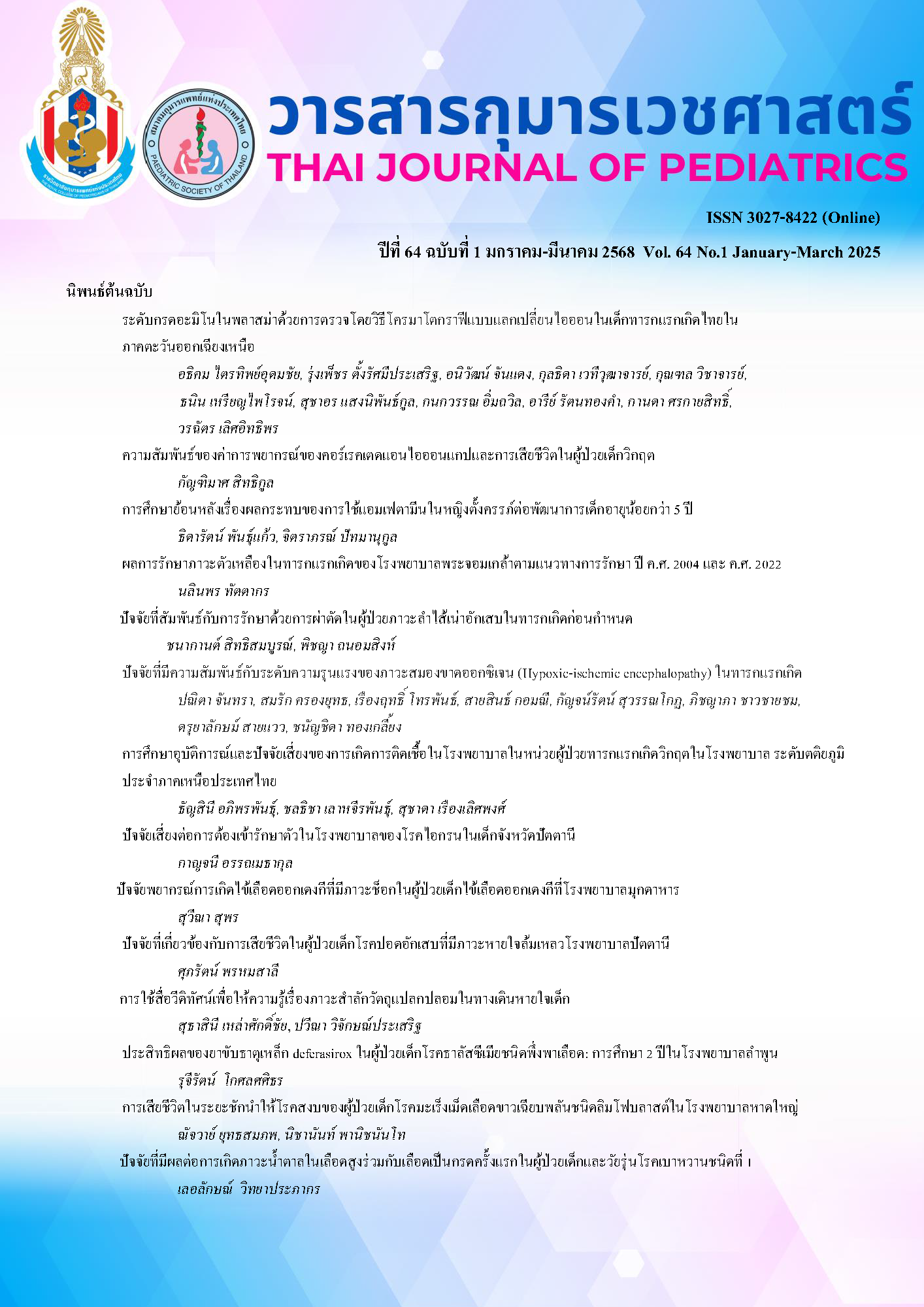the The incidence rate and risk factors of healthcare-associated infections in the neonatal care unit at a tertiary care hospital in northern Thailand
Keywords:
healthcare associated infections (HAI), neonatal intensive care unit, risk factor, mortality in neonate, bloodstream infectionAbstract
Background: Healthcare-associated infection (HAI) is a common complication in neonatal intensive care unit (NICU) which is the important cause of mortality and morbidity in neonates.
Objective: To investigate the incidence rate of HAI, risk factor associated to HAI and the bacteriological profile of micro-organisms affecting infection in NICU.
Method: A 1-year prospective cohort study collecting data in neonates admitted in NICU between August 20, 2023 and August 20, 2024.
Results: Total population in this study were 624 neonates founded HAI 107 episodes, the incidence rate of HAI was 17.2%. Risk factors associated with HAI were birth asphyxia (Apgar score at 5 min less than 7) (aHR 2.44, p value 0.03), umbilical venous catheter (UVC) insertion longer than 7 days (aHR 1.88, p value 0.04) and longer length of stay (aHR 0.97, p value 0.02). Common types of infection were primary bloodstream infection (35.5%), ventilator-associated pneumonia (22.4%) and central line-associated bloodstream infection (17.8%). Organism was not detected 55.1%. The three most common pathogens detected were Acinetobacter baumannii (24.3%), coagulase-negative staphylococcus (7.5%) and Escherichia coli (3.1%), respectively.
Conclusion: The incidence rate of HAI in neonates admitted in NICU was 17.2%.
Downloads
References
Sass L, Karlowicz MG. Healthcare-associated infections in the neonate. Principles and Practice of Pediatric Infectious Diseases. 2018;560-6.e3.
Stoll BJ, Hansen N, Fanaroff AA, Wright LL, Carlo WA, Ehrenkranz RA, et al. Late-onset sepsis in very low birth weight neonates: The experience of the NICHD neonatal research network. Pediatrics. 2002;110:285–91.
Choobdar F, Vahedi Z, Khosravi N, Khalesi N, Javid A, Shojaee S. Nosocomial infection in an Iranian neonatal intensive care unit: hospital epidemiology and risk factors. Arch Pediatr Infect Dis. 2020;11:8.
Kumar S, Shankar B, Arya S, Deb M, Chellani H. Healthcare associated infections in neonatal intensive care unit and its correlation with environmental surveillance. J Infec Pub Health. 2018;11:275–9.
Vain NE, Farina D, Vazquez LN. Neonatology in the emerging countries: the strategies and health-economics challenges related to prevention of neonatal and infant infections. Early Hum Dev. 2012;88:S53–9.
Demirdag BT, Koc E, Tezer H, Oguz S, Satar M, Saglam O, et al. The prevalence and diagnostic criteria of health-care associated infections in neonatal intensive care units in Turkey: A multicenter point- prevalence study. Pediatr Neonatol. 2021;62:208–17.
Dramowski A, Aucamp M, Beales E, Bekker A, Cotton MF, Fitzgerald FC, et al. Healthcare-associated infection prevention interventions for neonates in resource-limited settings. Frontiers in pediatrics. 2022;7:10.
Orsi GB, d’Ettorre G, Panero A, Chiarini F, Vullo V, Venditti M. Hospital-acquired infection surveillance in a neonatal intensive care unit. Am J Infec Control. 2009;37:201–3.
Auriti C, Ronchetti MP, Pezzotti P, Marrocco G, Quondamcarlo A, Seganti G, et al. Determinants of nosocomial infection in 6 neonatal intensive care units: An Italian multicenter prospective cohort study. Infection control & hospital epidemiology. 2010;31:926–33.
Leksakundilok P, Leksakundilok J, Ounchanum P. Incidence of ventilator-associated pneumonia in preterm very low birth weight neonates with positive tracheal aspirate cultures. วารสารกุมารเวชศาสตร์. 2565;61:172-9.
Wright MO, Hebden JN, Allen-Bridson K, Morrell GC, Horan T. Healthcare-associated infections studies project: An American journal of infection control and national healthcare safety network data quality collaboration. Am J Infec control. 2010;38:416–8.
CDC/NHSN surveillance definitions for specific types of infections [Internet]. 2020. [cited 2022 Oct 30] Available from: https://www.cdc.gov/nhsn/pdfs/pscmanual/17pscnosinfdef_current.pdf
Centers for Disease Control and Prevention. Catheter-associated urinary tract infection (CAUTI) [Internet]. 2024. [cited 2022 Oct 30] Available from: https://www.cdc.gov/nhsn/pdfs/ pscmanual/ 7psccauticurrent.pdf
Jeong IS, Jeong JS, Choi EO. Nosocomial infection in a newborn intensive care unit (NICU), South Korea. BMC Infect Dis. 2006;33:686-92.
Zheng X, He D, Yang Z, Chen L, Jiang M, Qi Y, et al. Dwell time and bloodstream infection incidence of umbilical venous catheterization in China. Pediatr Investig. 2023;7:239-46.
Corso L, Buttera M, Candia F, Sforza F, Rossi K, Lugli L, et al. Infectious risks related to umbilical venous catheter dwell time and its replacement in newborns: A narrative review of current evidence. Life. 2024;13:123.
Petdachai W. Nosocomial pneumonia in a newborn intensive care unit. J Med Assoc Thai. 2000;83:392-7.
Ibrahim S, Al-Saryi N, Al-Kadmy IMS, Aziz SN. Multidrug-resistant Acinetobacter baumannii as an emerging concern in hospitals. Mol Biol Rep. 2021;48:6987-98.
Downloads
Published
How to Cite
Issue
Section
License
Copyright (c) 2025 The Royal College of Pediatricians Of Thailand

This work is licensed under a Creative Commons Attribution-NonCommercial-NoDerivatives 4.0 International License.


